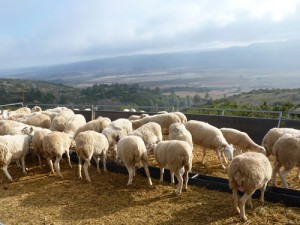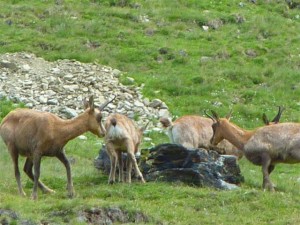It all started back in February when Magali drove me up the mountain above the village to see her flock. She has 60 sheep and a handful of goats. This is her first year in her new job as a shepherdess.
When we arrived at the enclosure gate something flashed by in front of us, jumping over the fence and bounding away.
“Did you see it?” she asked me. “The isard?”
“Not really. But what’s it doing here anyway? It should be in the Pyrenees,” I objected.
“I don’t know why it’s here, but don’t tell anyone,” she whispered, although there was no one else to hear. “I don’t want the hunters to kill him.”
Two days later a hunter friend rang me up: “Have you seen the isard?” he asked.
“No,” I lied.
“On the mountain. Some officials have been to see it because isards are a protected species.”
I saw Magali again a fortnight later. Two of her ewes were dead and one was dying. They all had bloody wounds on their flanks.
“Dogs?” I asked.
“No. The isard.”
“Do they attack sheep?”
“I think he tried to mount the ewes and when they refused he stuck his horns into them.”
I have heard of bears, wolves and dogs attacking sheep, but never isards, so I asked Gila Chevillon who has kept sheep since the 1970s. Isards can’t mate with sheep, she told me. They are two different species: isards have hair, sheep have fleece. Not the same! She had never heard of them attacking sheep either.
The other question is what the isard was doing here in the first place? They normally live in the Pyrenees over 100km away, and 1000m higher up. Could it have been brought up in captivity somewhere nearby and escaped? This might explain its lack of sexual discrimination, but the rumour that there had been a ‘tame’ isard in a nearby village proved to be unfounded.
One day, it simply disappeared.
But just today Magali has told me that her goats’ udders are swelling. She doesn’t have a billy goat. “It must be the isard,” she insists. Can it be true? We’ll have to wait until the end of June to find out.
***
In the meantime, Veronica and I have started eating one of Magali’s lambs. Here is Veronica’s recipe.
Roast leg of lamb (the 26-minute method)
1 leg of lamb (about 2 kg)
for the marinade (optional)
olive oil
orange zest
lemon zest
aromatics of your choice: garlic, orange zest, rosemary, anchovies …
salt and pepper
Marinade the leg if you like, but in any case make sure it is at room temperature before cooking. Spike it with a knife and insert garlic, lemon zest and anything else you fancy. Put it on a tray in an oven which has been pre-heated to 260 degrees C – as hot as possible – for 20 minutes, turn it over and cook for a further 6 minutes. Take it out and wrap it thoroughly in aluminium foil followed by blankets. Put it in a cool box (to keep it hot) for 1 hour 30 minutes.
Not only is the result delicious, with all the juices retained, but this method frees the oven up for other things. More on larecettedujour.org











Footprints on the mountains